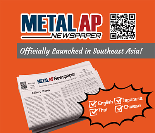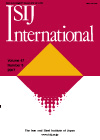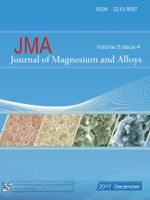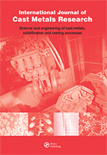
Archives of Foundry Engineering
Scope & Guideline
Nurturing the Future of Foundry Engineering Research
Introduction
Aims and Scopes
- Foundry Materials and Alloys:
Research on the properties, processing, and performance of various metal alloys and composites, including aluminum, magnesium, and cast iron, emphasizing their applications in different industries. - Casting Processes and Technologies:
Investigation into various casting techniques, including investment casting, die casting, and sand casting, along with studies aimed at optimizing these processes for quality and efficiency. - Defect Analysis and Quality Control:
Studies focusing on the identification, characterization, and mitigation of defects in castings, alongside methodologies for quality assurance and control in foundry operations. - Innovative Moulding Techniques:
Exploration of advanced moulding materials and techniques, including 3D printing and the use of novel binders, to enhance the performance and sustainability of foundry practices. - Environmental Impact and Resource Efficiency:
Research aimed at reducing the environmental footprint of foundry operations, including studies on recycling, waste management, and the use of sustainable materials. - Computational Modelling and Simulation:
Application of computational techniques and simulation models to predict and analyze the behavior of materials and processes in foundry engineering.
Trending and Emerging
- Sustainable Foundry Practices:
An increasing number of studies are focusing on sustainability in foundry operations, including the use of recycled materials and energy-efficient processes, reflecting the industry's commitment to environmental responsibility. - Advanced Characterization Techniques:
There is a growing trend towards employing advanced characterization methods, such as X-ray tomography and electron microscopy, to study the microstructure and properties of cast materials. - Additive Manufacturing in Casting:
Research on the integration of additive manufacturing technologies, particularly 3D printing of sand molds and cores, is gaining traction, indicating a shift towards innovative production methods. - Smart Foundry Technologies:
Emerging themes include the application of IoT and data analytics in foundry operations, enhancing monitoring, control, and predictive maintenance of casting processes. - Nano-materials and Composites:
An increasing focus on the development and application of nano-materials and advanced composites in casting processes is evident, indicating a trend towards high-performance materials.
Declining or Waning
- Traditional Casting Techniques:
There has been a noticeable decrease in publications focusing on conventional casting techniques, as the field shifts towards more innovative and technologically advanced methods. - Basic Metallurgical Studies:
Research centered on fundamental metallurgical principles, while still relevant, appears to be less emphasized compared to applied research and technological advancements in casting. - Generalized Process Optimization:
Studies providing broad optimization strategies without specific applications have decreased, with a growing preference for targeted, application-specific research. - Historical Case Studies:
The journal has seen fewer publications related to historical analyses of foundry practices, suggesting a shift towards contemporary issues and future-oriented research. - General Foundry Management Topics:
There is a decline in papers addressing general management practices within foundries, as more focus is placed on technical and engineering advancements.
Similar Journals

International Journal of Metalcasting
Catalyzing Innovation in the Metalcasting SectorThe International Journal of Metalcasting, published by Springer International Publishing AG, stands at the forefront of research in the fields of Industrial and Manufacturing Engineering, Materials Chemistry, Mechanics of Materials, and Metals and Alloys. With an impressive impact factor and ranking in the Q2 category across multiple disciplines for 2023, this journal is integral for scholars and practitioners alike seeking rigorous insights and advancements in metalcasting technologies. Through its dedication to publishing high-quality, peer-reviewed research, the journal acts as a vital platform for knowledge exchange and innovation in the metalcasting sector. It provides critical access to cutting-edge methodologies, contemporary challenges, and novel applications, and it aims to enhance the global dialogue surrounding metalcasting practices. Researchers, industry professionals, and students will find the International Journal of Metalcasting a valuable resource for both academic and practical applications, promoting excellence in metallurgical engineering.

Russian Journal of Non-Ferrous Metals
Delivering Insights into Non-Ferrous MetallurgyThe Russian Journal of Non-Ferrous Metals, published by PLEIADES PUBLISHING INC, serves as a vital resource for researchers and professionals in the fields of materials science and engineering. With a dual ISSN (1067-8212 for print and 1934-970X for online), this journal has been instrumental in disseminating cutting-edge research from 2007 to 2023. Specializing in the mechanics of materials, metals and alloys, and the study of surfaces, coatings, and films, it provides invaluable insights into the latest advancements and applications in these areas. Although currently categorized in the Q4 tier for mechanics of materials and surfaces, and Q3 for metals and alloys in the 2023 rankings, its commitment to quality research is reflected in its Scopus metrics, ranking it within the competitive spectrum of its fields. While not an open access journal, it remains a crucial academic platform for fostering knowledge exchange among professionals and scholars. By publishing high-quality articles, the Russian Journal of Non-Ferrous Metals contributes significantly to the ongoing dialogue in metallurgical science and engineering.

Manufacturing Review
Unlocking the Future of Manufacturing TechnologiesManufacturing Review, published by EDP SCIENCES S A, is a leading open access journal dedicated to advancing the field of industrial and manufacturing engineering. With its ISSN 2265-4224 and a commendable impact factor reflected in its 2023 ranking of Q2 among its peers, the journal serves as a crucial platform for researchers, professionals, and students interested in the evolution of manufacturing technologies and processes. The journal has been open access since 2014, promoting widespread dissemination of knowledge and fostering collaborations across the globe. Operating from its headquarters in France, Manufacturing Review features a diverse range of topics pertinent to contemporary challenges in manufacturing, aiming to keep the community informed and engaged. As it converges into its defined scope from 2014 to 2024, readers can expect cutting-edge research that pushes the boundaries of innovation and application in the manufacturing sector.

China Foundry
Connecting Global Scholars in Materials ChemistryChina Foundry is a prestigious journal published by SPRINGER SINGAPORE PTE LTD, specializing in the fields of materials chemistry and metals and alloys. With an impact factor that showcases its reputable standing, this journal is categorized within the Q2 quartile for both Materials Chemistry and Metals and Alloys as of 2023. As an Open Access journal since 2004, it ensures that cutting-edge research is readily available to a global audience, promoting knowledge dissemination among researchers, professionals, and students alike. With a rich history converging from 2008 to 2024, China Foundry serves as a critical resource for the latest advancements and innovations in foundry technology, materials processing, and related fields. The journal's commitment to excellence is also reflected in its Scopus ranks, positioning it favorably within the competitive landscape of materials science. By fostering academic discourse and collaboration, China Foundry is an essential platform for those looking to contribute to and engage with the fast-evolving world of materials science.

International Journal of Precision Engineering and Manufacturing
Elevating Standards: Your Source for Cutting-Edge Engineering ResearchInternational Journal of Precision Engineering and Manufacturing, published by the Korean Society of Precision Engineering, is a key academic platform dedicated to the advancement of research in the fields of precision engineering and manufacturing. With an ISSN of 2234-7593 and an E-ISSN of 2005-4602, this esteemed journal caters to a diverse readership, including researchers, industry professionals, and students, who are committed to exploring innovative solutions in Electrical and Electronic Engineering, Industrial and Manufacturing Engineering, and Mechanical Engineering. Operating from South Korea, the journal has attained a commendable Q2 ranking in several engineering categories as of 2023, reflecting its influence and relevance in the academic community. Though it is not an open access journal, the International Journal of Precision Engineering and Manufacturing provides vital insights and updates in precision technology, bridging the gap between theory and practice. Researchers are encouraged to contribute to this evolving field and engage with high-quality studies that drive progress and innovation.

ISIJ INTERNATIONAL
Exploring the Frontiers of Materials Chemistry and EngineeringISIJ INTERNATIONAL is a distinguished open-access journal in the fields of Materials Chemistry, Mechanical Engineering, Mechanics of Materials, and Metals and Alloys, published by the esteemed IRON STEEL INST JAPAN KEIDANREN KAIKAN. Since its inception in 1986, ISIJ INTERNATIONAL has played a pivotal role in disseminating advanced research and critical findings in steel and iron industries, significantly contributing to innovations in materials science and engineering. With a commendable impact factor and categorized in Q2 quartiles across its relevant fields in 2023, the journal ranks favorably among other prestigious publications, evidencing its influence and relevance within the academic community. The journal promotes open access, allowing unrestricted online access to its published work since 2012, thus ensuring that researchers, professionals, and students can readily access cutting-edge research. The journal's comprehensive scope empowers researchers to connect over pioneering studies and methodologies that address contemporary challenges in materials and engineering domains, thereby fostering a rich dialogue and knowledge exchange.

Journal of Magnesium and Alloys
Connecting Global Minds in Magnesium ResearchThe Journal of Magnesium and Alloys is a prestigious, peer-reviewed academic publication dedicated to advancing the field of materials science, particularly focusing on magnesium and its alloys. Published by KEAI PUBLISHING LTD since 2013, this Open Access journal enables unrestricted dissemination of research findings, enhancing global collaboration among researchers, professionals, and students. With an ISSN of 2213-9567 and a significant impact factor, it has established itself in the upper quartiles (Q1) of both the Mechanics of Materials and Metals and Alloys categories, ranking #3 out of 176 and #9 out of 398 respectively according to Scopus. The journal aims to provide a forum for the latest advances in the understanding, production, and application of magnesium alloys, fostering innovation and sustainable practices within the materials engineering community. Based in Beijing, China, the journal is committed to bridging gaps in current knowledge and driving future research directions through its high-quality publications.

INTERNATIONAL JOURNAL OF CAST METALS RESEARCH
Advancing the Frontiers of Cast Metals KnowledgeInternational Journal of Cast Metals Research, published by Taylor & Francis Ltd, serves as a premier platform for the dissemination of cutting-edge research in the fields of Mechanical Engineering, Mechanics of Materials, and Metals and Alloys. With a commitment to advancing the understanding of cast metals, this peer-reviewed journal has achieved notable recognition, featuring a 2023 Q2 ranking in its respective categories and ranking 71st in the Materials Science field according to Scopus. Researchers and professionals will find a wealth of valuable insights through rigorous studies and innovative findings, reflecting the journal's goal of facilitating knowledge transfer and addressing contemporary challenges in material science. Furthermore, its accessible publication years from 1996 to 2024 ensure that it not only captures the evolution of technology in cast metals but also stands at the forefront of future developments. Ideal for academics and practitioners alike, the journal aims to foster collaboration and inspire new developments within the discipline.

Metallurgical Research & Technology
Exploring the forefront of materials science and engineering.Metallurgical Research & Technology is a distinguished journal published by EDP SCIENCES S A based in France, focusing on the dynamic field of metallurgical science and engineering. With a strong emphasis on the latest advancements in Materials Chemistry, Computational Mechanics, and Mechanics of Materials, this journal aims to provide a platform for researchers to share innovative findings that propel the field forward. As of 2023, it has secured a commendable position in various categories, including Q3 rankings in Computational Mechanics, Materials Chemistry, and Mechanics of Materials, along with a Q2 ranking in Metals and Alloys. The journal actively promotes open access, facilitating broader dissemination of critical research across the globe. Researchers, professionals, and students in the metallurgical domain will find Metallurgical Research & Technology an invaluable resource for cutting-edge developments and collaborative opportunities.

MANUFACTURING ENGINEERING
Pioneering Research for Tomorrow's Manufacturing ChallengesManufacturing Engineering is a pivotal journal specializing in the fields of Industrial and Manufacturing Engineering, as well as Mechanical Engineering, with a rich history of publication since its inception in 1975. Published by the esteemed Société des Ingénieurs de Fabrication (SME), this journal plays a crucial role in disseminating innovative research, practical applications, and emerging technologies that shape the manufacturing sector. Despite its recent positioning in the Q4 quartile rankings on Scopus, the journal serves as a platform for rigorous peer-reviewed articles that contribute to the academic dialogue and bolster advancements in manufacturing practices. The journal operates without open access options, making it an essential resource for institutions and professionals looking to stay informed within the manufacturing domain. With a dedicated audience comprising researchers, engineers, and industry professionals, Manufacturing Engineering continues to address the evolving challenges and opportunities in manufacturing, fostering an environment ripe for collaboration and exploration.